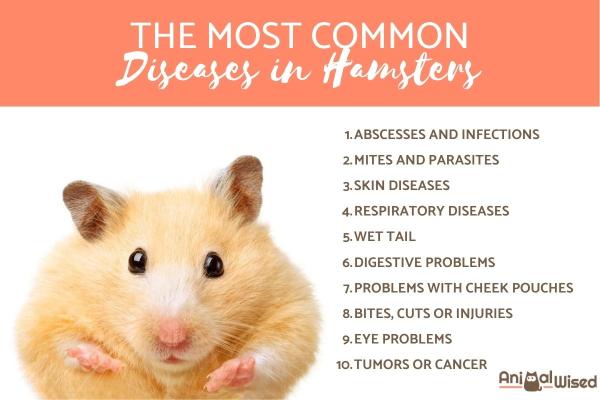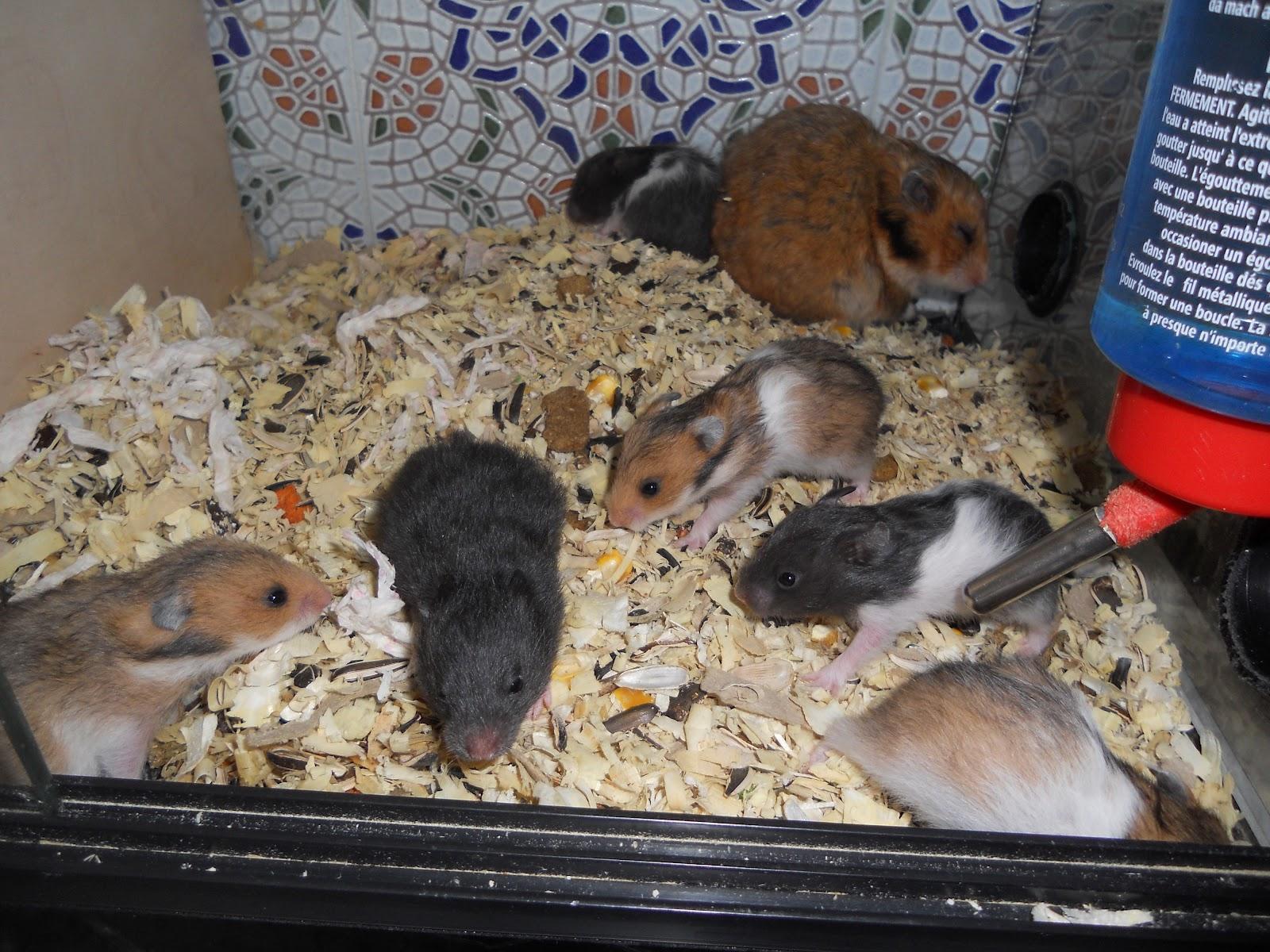Most Common Hamster Diseases



See files for Hamsters
Hamsters are popular pets with children as they are relatively easy to care for. However, when we adopt a hamster into the family, we need to ensure we meet the responsibility of meeting their health needs. This means looking out for signs and symptoms of diseases common to hamsters. One of the main issues is that hamsters are largely nocturnal animals and we may not always be around to observe some of these symptoms. Moreover, many of the initial symptoms of hamster diseases are not very obvious and, therefore, go unnoticed until the problem has exacerbated.
Our AnimalWised list of the most common hamster diseases provides the 10 biggest threats to hamster health. By familiarizing ourselves with them, we can best safeguard our hamsters from diseases which can result in their dying.
- The 10 most common hamster diseases
- Abscesses and infections
- Mites and parasites
- Skin diseases in hamsters
- Respiratory diseases in hamsters
- Wet tail in hamsters
- Digestive problems in hamsters
- Problems with cheek pouches
- Bites, cuts or injuries
- Eye problems in hamsters
- Tumors or cancer in hamsters
The 10 most common hamster diseases
We need to not only understand what diseases are common to hamsters, but what we can do to prevent them. Looking after hamster heath requires various approaches. Firstly, we need to provide them with the correct diet. If the hamster lacks nutrition, not only can they suffer developmental problems, but their immune system can be weakened. The latter results in the rodent being unable to fend off otherwise treatable health problems.
Our article on what do hamsters eat will help you to know what you need to ensure a hamster has a balanced diet.
Hygiene is another very important issue. If the hamster's cage is not cleaned regularly, it promotes the proliferation of various bacteria, viruses and parasites. It is not only the hamster's physical health we need to consider. Problems with their psychological well-being can have detrimental physical repercussions.
By taking good care of our hamsters and meeting their basic needs, we can avoid the most common health problems in hamsters. These include:
- Abscesses and infections
- Mites and parasites
- Skin diseases
- Respiratory diseases
- Wet tail
- Digestive problems
- Problems with cheek pouches
- Bites, cuts or injuries
- Eye problems
- Tumors or cancer
Now we look into these common health problems of hamster in greater detail. If you want to know more, you can take a look at our list of interesting facts about hamsters.
1. Abscesses and infections
Abscesses can occur on almost any part of the body. They begin as small bumps which start to protrude more and more due to a reaction in the hamster's immune system. This protrusion is caused by the accumulation of pus underneath the skin which eventually erupts. Abscesses are different from tumors and are caused by a bacterial infection.
The bacterial infection may be secondary. For example, a parasite may bore into the skin of the hamster, leaving a wound which is open to bacteria and subsequent infection. Often an abscess will be the result of poorly healed cuts or bites. Treatment will depend on the severity of the infection and extent of the abscess. Usually, it will erupt or subside on its own and the symptoms will disappear. In extreme cases, the abscess will need to be drained and the infected area cleaned. If the infection does not resolve itself, the hamster will need antibiotic treatment.

2. Mites and parasites
Another of the most common diseases in hamsters are related to mites and other parasites. Most hamsters will have some mites on their body. However, they do not cause any symptoms of disease until the infestation becomes acute or if the hamster has a weakening of the immune system. Similarly, if the hamster has a bacterial or viral infection, the immune system's battle with these problems make them more vulnerable to parasites.
Common symptoms of parasitical infestation in hamsters include excessive itching, red skin, eczema (dry flaky skin) or general restlessness. The treatment of the problem will depend on the cause. Since specific products are required to specific parasites, a veterinarian is required to both diagnose the problem and prescribe the correct treatment.
Maintaining their cage is imperative in preventing health problems in hamsters caused by parasites. If we do not clean the cae regularly, parasites are more likely to proliferate. This is especially the cause when more than one hamster lives together.
Some parasites can cause such serious problems, they threaten the hamster's life. Our article on the signs and symptoms of dying hamsters will help you to know more.
3. Skin diseases in hamsters
Bacterial infections, parasites and other causes lead to skin problems in hamsters, but there are many reasons why a hamster might have skin problems. Even if they are stressed, it can result in problems such as dermatitis (inflammation of the skin) or alopecia (hair loss). Since there are so many possible causes of skin diseases in hamsters, we need to take them to a veterinarian to have them properly diagnosed.
We should note that male hamsters have scent glands which can give off a strong scent. This does not mean they have a skin disease, although we should be careful as some skin problems can also provide an odor. We should look to other possible symptoms to determine whether it is due to normal scent gland secretion or worrying health problem.
If your hamster stops moving, some may think they are hibernating. However, domestic hamsters generally do not hibernate, so it is more likely they have a serious threat to their health.
4. Respiratory diseases in hamsters
As with skin diseases in hamsters, respiratory problems can have various causes. Some of the most common respiratory problems in hamsters are colds, bronchitis and pneumonia. These can be exacerbated by exposure to cold temperatures or persistent drafts.
Symptoms of respiratory problems in hamsters include:
- Breathing difficulties
- Sneezing
- Whezing
- Loss of appetite
- Watery eyes
- Stooping
- Tremors
- Immobility
- Runny nose
- Coughing
- Redness around the nose
The sounds of coughing which a hamster makes will not likely be the same as a human. They can sound like squeaking or similar noises. However, they will be different from their usual hamster sounds.
Treatment for these respiratory diseases requires rest, a warm area, plenty of water and food. We should take them to the veterinarian in case the problem requires antibiotic treatment.
One cause of respiratory problems in hamsters may not be obvious to you. There are various types of substrate used for hamsters and similar pets. However, not all are suitable for hamsters. Pine and cedar shavings are particularly bad for hamsters. Not only are they sharp and can cause practical damage, but dust from these shavings can result in severe respiratory problems as it collects in their lungs. Fluffy bedding is often made from synthetic fibers which can also lead to breathing issues. Cat litter and newspaper also need to be avoided at all costs.

5. Wet tail in hamsters
Proliferative ileitis, more commonly known as wet tail, is one of the most common and most contagious hamster diseases. Wet tail is a disease which usually affects younger hamsters (3-10 weeks of age). It is especially common in those which have been recently weaned. It can be a symptom of stress in hamsters, but it is also related to overpopulation in the cage, poor diet or poor hygiene maintenance.
The condition is caused by bacteria which can be found in the gut of hamsters known as colibacteria. This bacteria can be present without causing any harm, but the previously mentioned situations can cause them to be activated. The incubation period of wet tail is about 7 days and the most common symptom is particularly wet diarrhea. Their tail region will look very dirty, but they will also suffer a loss of appetite and can become seriously dehydrated.
Treatment of set tail is similar to that of gastroenteritis. The animal will need to be rehydrated and provided with sufficient nourishment. Any affected hamsters will need to be separated from others to stem the spread of this disease. You will need to take the hamster to the veterinarian in case they need antibiotics prescribed. However, they may also need to provide fluid therapy if the hamster is severely dehydrated.
6. Digestive problems in hamsters
Diarrhea and constipation are not diseases in themselves. However, they are symptoms of various gastrointestinal problems in hamsters. They are also not the same, but opposite problems.
In the case of diarrhea, the animal's stools are overly soft or even liquid. The anal region will be very dirty and you can see the stool is unlike the normal hard pellets of a healthy hamster. Diarrhea in hamsters can be caused by bacterial infections, too much fruit in the diet, poor hygiene and more. It is a gastrointestinal problem itself, but can also be a symptom of many diseases.
In the case of constipation, there will be a lack of excrement in the hamster's cage. The hamster's anus may be swollen and there may be visible signs of pain. If the hamster is constipated for a protracted period of time, their belly will swell due to the accumulation of digested food. It is usually caused by a poor diet. Treatment can be in the form of laxatives or fruit and vegetables which have a laxative effect.

7. Problems with cheek pouches
Hamsters have cheek pouches which are used to store excess food. This can be found in other animals, such as some monkeys and chipmunks. They are used to transport food or to collect large amounts quickly. This is related to wild hamster behaviors whereby food collection is needed to survive times when food is not as accessible.
Unlike some mammals, the hamster's pouches are dry, not wet. When something sticky gets into the pouch, it can lead to problems. They may be unable to empty their pouches which result in wounds or abscesses. If your pet suffers from a problem, you will likely see inflammation of the cheek areas. Treatment will be carried out by a veterinarian. They will be able to extract the food and treat any injuries which may have been caused in the meantime.
8. Bites, cuts or injuries
Hamsters can live well with others, but this will depend whether they are a male or female hamster. Males do not tend to get on with other males and will fight over territory. Males can get on with females, but they will also breed which is not advisable. However, any two hamsters may get in a fight which results in cuts or injuries.
Typically, affected hamsters will only have superficial wounds which heal within a few days. However, if their cage is not clean or they are otherwise exposed to bacteria, it can cause these wounds to become infected. Serious wounds or extensive bleeding will require veterinary attention. They may also require antibiotic treatment if the cuts or injuries become infected.
9. Eye problems in hamsters
Irritation in the eyes of the hamster can be mild, but soon develop into a more serious infection. Such irritation can cause the hamster to try to scratch the eye, resulting in trauma or introducing more bacteria into the affected eye. The cause of the eye problem may be an injury from sharp substrate, dust, injury from another hamster or any kind of bacterial eye infection.
Symptoms include excess tearing in the eyes, bulging eyes, redness or other signs of infection. In the case of a mild eye infection, we may be able to help by cleaning the eye regularly with sterile water and gauze. However, persistent eye problems will require veterinary treatment. The vet may prescribe saline or medicated eye drops. These drops may have antibiotics if the problem is related to a bacterial infection.

10. Tumors or cancer in hamsters
Tumors are masses of tissue which cab occur both internally and externally in hamsters. These masses are caused by the proliferation of cell reproduction, something which can be benign or malignant. Malignant tumors are usually cancerous which can metastasize to other parts of the body and be potentially fatal.
One of the biggest threats to a hamster's health is cancer. Cancerous tumors need to be differentiated from other neoplasms such as cysts. Malignant tumors are usually hard and do not move when pressed. There are many factors related to cancer in hamsters, but age is perhaps the most important. Older hamsters are much more likely to develop cancers. Apart from tumors, the symptoms of cancer in hamsters can include los of appetite, weight loss, alopecia and reduced activity.
External tumors may be removed by surgical intervention, but there is no guarantee the cancer won't return. Most hamster cancers will go untreated due to the difficulty and cost of treatment. Especially since the problems are related to older hamsters, the treatment is usually palliative. If the disease has progressed sufficiently, the hamster may be euthanized as the pain may impede their quality of life dramatically.
If you want to help prevent your hamster from developing any of the diseases mentioned in this article, you will need to ensure their general care needs are met. Our video below will provide some useful background information to get your started:

This article is purely informative. AnimalWised does not have the authority to prescribe any veterinary treatment or create a diagnosis. We invite you to take your pet to the veterinarian if they are suffering from any condition or pain.
If you want to read similar articles to Most Common Hamster Diseases, we recommend you visit our Prevention category.









